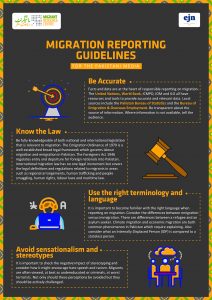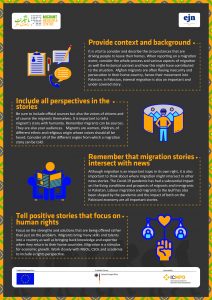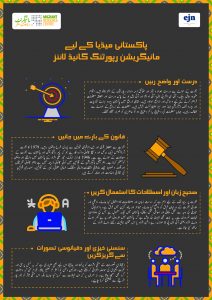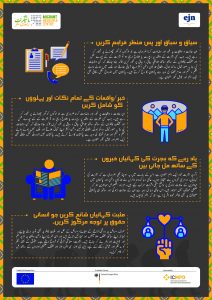International Centre for Migration Policy Dialogue (ICMPD) – Migration Reporting Fellowship for the Pakistani media
Following a series of online consultations with Pakistani media in November and December 2020, the EJN has developed a set of guidelines for reporting on migration and a journalists’ toolkit for migration reporting for the Pakistani media.
This project was enhanced with a month-long online training course in June 2021, for 21 journalists from across Pakistani media and which was followed by mentoring and a grants scheme facilitated by the ICMPD. Journalists from the following media took part: Pakistan TV, Geo TV, Dawn, Current, Samaa, Naya Daur and Tribal News Network.
These guidelines are now available as infographics in both English and Urdu. They have been produced in partnership with the ICMPD and the Migrant Resource Centre, with funding from the European Union and the German Federal Foreign Office. Download the infographics for use in your newsroom.




Migration Reporting Guidelines for the Pakistani media
Be Accurate
Facts and data are at the heart of responsible reporting on migration. The United Nations, World Bank, ICMPD, IOM and ILO all have resources and tools to provide accurate and relevant data. Local sources include the Pakistan Bureau of Statistics and the Bureau of Emigration & Overseas Employment. Be transparent about the source of information. Where information is not available, tell the audience.
Know the Law
Be fully knowledgeable of both national and international legislation that is relevant to migration. The Emigration Ordinance of 1979 is a well-established legal framework which governs labour migration and emigration in Pakistan. The Foreigners Act 1946 regulates entry and departure for foreign nationals in Pakistan. International migration law has no one legal instrument but covers the legal definitions and regulations related to migrants in areas such as regional arrangements, human trafficking and people smuggling, human rights, labour laws and maritime law.
Use the right terminology and language
It is important to become familiar with the right language when reporting on migration. Consider the differences between emigration versus immigration. There are differences between a refugee and an asylum seeker. Climate migration and economic migration are both common phenomenon in Pakistan which require explaining. Also consider what an Internally Displaced Person (IDP) is compared to a stateless person.
Avoid sensationalism and stereotypes
It is important to check the negative impact of stereotyping and consider how it might encourage hate speech and racism. Migrants are often viewed, at best as undereducated or criminals, at worst terrorists. Not only should these perceptions be avoided but they should be actively challenged.
Toolkit: Guidelines for Reporting Migration in Pakistan
The toolkit includes professional guidelines that are intended to provide a useful reference for journalists as well as international and national legal mechanisms relating to migration as ethical reporting must be grounded in fact. However, the journalistic principles discussed are intended as a good practice guide rather than hard and fast rules. They may need to be adapted depending on the local context.
The guidelines have been developed through a series of online consultations conducted with journalists in Pakistan in late 2020. The he guidelines address challenges that journalists said they faced when reporting on migration topics, and they support the development of ethical reporting practices when covering migration issues related to Pakistan.
Read More
The EJN’s Migration Reporting Guidelines
To provide support to journalists covering migration the EJN launched new guidelines in September 2016 at the Global Forum for Media Development. Download the guidelines here, or watch the video below explaining them by the EJN’s chair Dorothy Byrne.